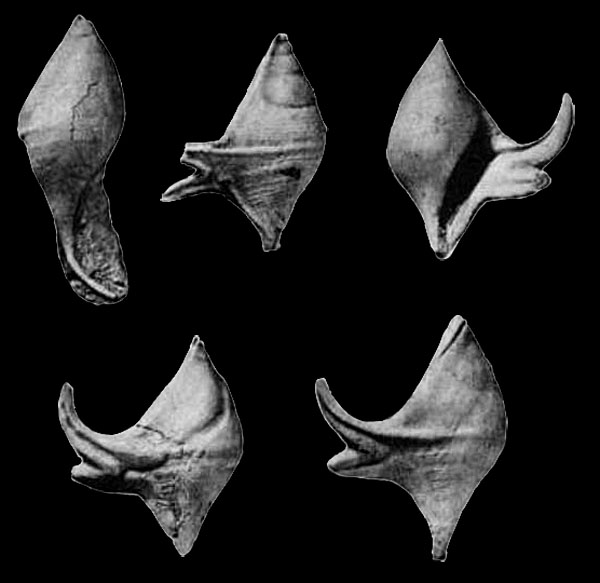Stromboidea
Original description of Lispodesthes patula by Stephenson, 1952:
- ”Shell of medium size, with an apical angle of about 50°; from the apex downward, the spiral angle decreases to about 35° on the larger whorls. On most shells the protoconch is either broken or worn away or is concealed by the outer coating of callus; as seen on one paratype it is a low smooth turbinate shell of 1 or 1˝ turns. Suture closely appressed and slightly impressed. Whorls 4, very gently convex in lateral profile. In the presenile stage the shell is ornamented with numerous, low, narrow spiral lirae of irregular size and spacing; these number at least 25 on the body whorl. On the body whorl two of the lirae on the inflated part begin to enlarge as they approach the aperture, and become conspicuous as they pass out onto the expanded outer lip, one traversing the upper, and the other the lower, of the projecting spurs. The periphery of the body whorl is broadly rounded, the base descends with moderate steepness, becoming broadly excavated below. Growth lines strongly sinuous on the body whorl. Aperture long, narrow-lanceolate, sinuous in trend; at the rear the aperture is acute, with a narrow anal canal deeply incised in thick callus, extending up the side of the spire to, and a little above, the apex. Anteriorly the aperture passes out into a low, narrow, strongly curved siphonal canal, which attains a length of 10 mm or more. In the adult the outer lip expands and forks, the upper prong curving regularly outward and upward in the form of a long-pointed spur and the lower prong passing downward and a little inward, forming a rather broad, dull-ending spur much shorter than the upper one. In the adult stage the mantle of the animal begins to fold back over the outer surface of the shell all around the aperture, depositing on the shell a layer of callus. As growth continues the mantle continuous to spread, thickening the callus on the lips, covering the surface and, eventually, in the senile stage, completely concealing the surface structure.
Locus typicus: 0.65 mile south, 1 mile west of Star School, northeastern Grayson County, Texas, USA
Stratum typicum: Templeton Member, Woodbine Formation, Cenomanian, upper Cretaceous
Dimensions: of the slightly incomplete holotype: height 25+ mm; diameter, exclusive of the expanded lip about 11 mm; including the lip, 20 mm.
Original comment of Stephenson, 1952 about Lispodesthes patula:
- ”Compared with Lispodesthes panda, this species is larger, has a higher spire, plumper whorls, and a longer siphonal canal, and in the adult is covered with a thicker and more conspicuous layer of callus.
Lispodesthes patula Stephenson, 1952, pl. 39, fig. 12 - 16
- image courtesy of the USGS
References

